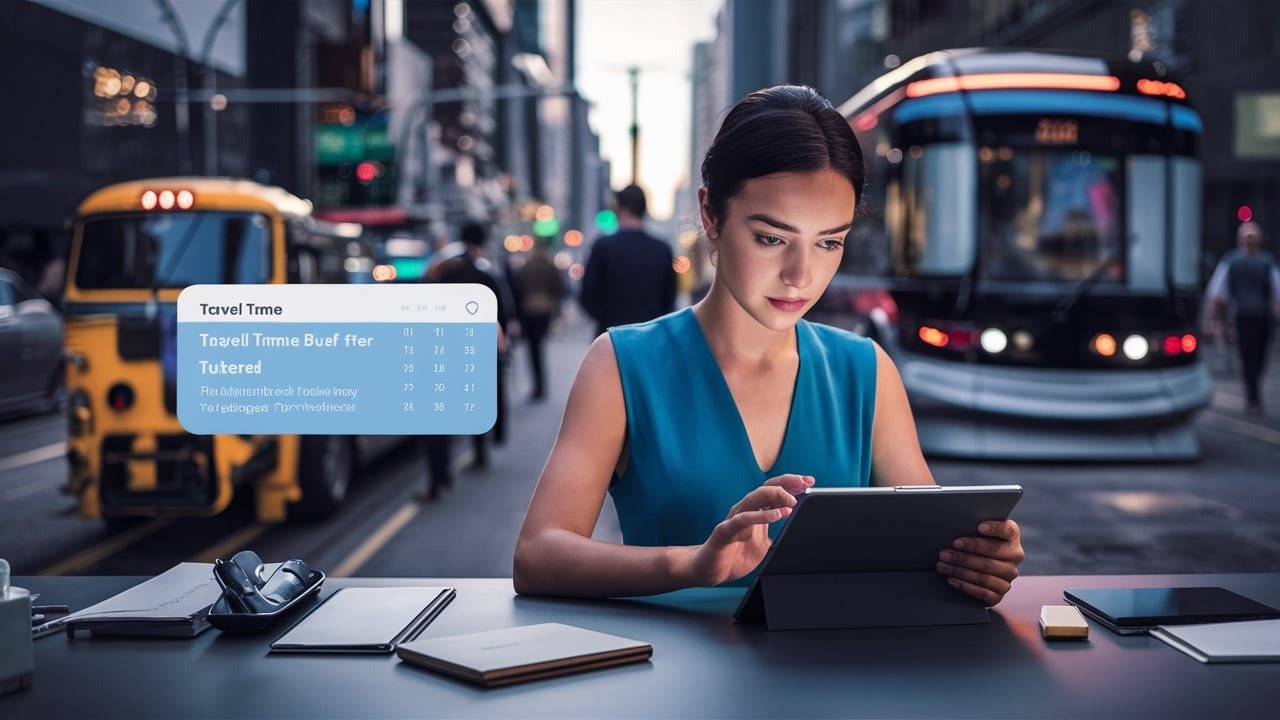Introduction
Effective time management is crucial for productivity and success in today’s fast-paced world, particularly for professionals who juggle multiple appointments and meetings. The Clio Calendar’s Travel Time Buffer feature is a game-changer, providing users with a powerful tool to enhance their scheduling efficiency and ensure they never miss an appointment due to unforeseen delays. This comprehensive guide explores the intricacies of Clio Calendar’s Travel Time Buffer, its benefits, and practical tips for making the most of this innovative feature.
Understanding Clio Calendar’s Travel Time Buffer
Clio Calendar, part of the Clio suite of legal practice management tools, is designed to streamline the scheduling process for legal professionals. One of its standout features is the Travel Time Buffer, which allows users to account for travel time between appointments. This feature is precious in professions where appointments are scheduled across different locations, and managing time efficiently is crucial.
What Is the Travel Time Buffer?
The Travel Time Buffer is a scheduling tool that enables users to automatically insert a designated period between meetings or appointments to account for travel time. This functionality helps to avoid the common issue of overlapping appointments caused by inadequate travel time estimates. By integrating travel time into the scheduling process, the Travel Time Buffer ensures a smoother, more organized day, minimizing the risk of delays and scheduling conflicts.
How It Works
To utilize the Travel Time Buffer, users can set a specific duration that will automatically be added to their calendar entries. For example, if you have a 30-minute meeting scheduled and put a 15-minute Travel Time Buffer, Clio Calendar will adjust your schedule to reflect a 15-minute gap between meetings. This adjustment ensures you have adequate time to travel from one location to another without the stress of running late.

Benefits of Using the Travel Time Buffer
The Travel Time Buffer offers a range of benefits that enhance time management and overall productivity. Here are some key advantages of incorporating this feature into your scheduling routine:
Improved Scheduling Accuracy
One of the primary benefits of the Travel Time Buffer is its ability to improve scheduling accuracy. By automatically accounting for travel time, users can avoid the common pitfall of scheduling back-to-back appointments without considering the time needed to get from one location to another. This accuracy ensures that appointments run smoothly and helps prevent overbooking or double-booking.
Reduced Stress and Increased Efficiency
Managing a busy schedule can be stressful, especially when travel time is not factored into appointments. The Travel Time Buffer alleviates this stress by providing a built-in cushion for travel. It leads to a more relaxed and efficient workday, as users can focus on their tasks without worrying about being late for their next appointment.
Enhanced Professionalism
Punctuality is a critical aspect of professionalism, particularly in client-facing roles. Using the Travel Time Buffer, professionals can demonstrate respect for their clients’ time by ensuring they arrive at meetings promptly. This reliability enhances the overall impression of professionalism and helps build strong client relationships.
Minimized Scheduling Conflicts
Scheduling conflicts can arise when appointments are not adequately spaced to account for travel. The Travel Time Buffer helps minimize these conflicts by automatically inserting the necessary time between appointments. This feature ensures that users have sufficient time to complete their meetings and travel to their next engagement, reducing the likelihood of overlapping appointments.
Flexibility and Customization
The Travel Time Buffer is highly customizable, allowing users to set different travel time durations based on their needs. For example, users can set longer buffers for appointments requiring extensive travel and shorter buffers for meetings closer to proximity. This flexibility ensures that the Travel Time Buffer can be tailored to various scheduling scenarios.

Setting Up the Travel Time Buffer in Clio Calendar
Setting up the Travel Time Buffer in the Clio Calendar is straightforward. You configure your calendar settings to include the desired travel time between appointments.
Access Your Calendar Settings
Begin by accessing your Clio Calendar settings. Log into your Clio account and navigate to the calendar section. Look for the settings or preferences option, typically found in the top-right corner of the calendar interface.
Locate the Travel Time Buffer Option
Locate the Travel Time Buffer option within the calendar settings. This feature may be listed under scheduling preferences or time management settings. Click on the Travel Time Buffer option to proceed with customization.
Set the Desired Travel Time
Once you’ve accessed the Travel Time Buffer settings, you’ll be prompted to enter the desired travel time duration. You want to allocate this time between appointments to account for travel. Enter the span in minutes or hours, depending on your inclination.
Apply the Settings
After setting the desired travel time, save or apply the changes to update your calendar settings. The Travel Time Buffer will be automatically included in your future appointments, ensuring that your schedule accounts for travel time.
Review and Adjust as Needed
It’s important to periodically review your Travel Time Buffer settings to ensure they continue to meet your needs. If your travel time requirements change, you can easily adjust the buffer duration in your calendar settings.
| Read More: help.clio.com |
Practical Tips for Maximizing the Travel Time Buffer
To make the most out of Clio Calendar’s Travel Time Buffer feature, consider the following practical tips:
Assess Your Travel Time Needs
Evaluate your typical travel time between appointments to determine an appropriate buffer duration. Consider factors such as traffic conditions, distance, and the type of appointments you have. Setting a buffer that aligns with your travel needs will ensure your schedule is accurately managed.
Combine with Other Scheduling Features
Combine the Travel Time Buffer with other scheduling features offered by Clio Calendar to enhance its effectiveness. For example, use the color-coding feature to differentiate between different types of appointments or integrate task management tools to keep track of your to-do list.
Communicate with Clients and Colleagues
When scheduling appointments, communicate your availability clearly to clients and colleagues. Tell them about the buffer time in your schedule to manage expectations and avoid misunderstandings. This communication ensures that everyone knows your time constraints and can plan accordingly.
Monitor and Adjust for Accuracy
Monitor your schedule regularly to ensure the Travel Time Buffer accurately reflects your travel needs. Adjust the duration accordingly if you notice that your buffer needs to be longer or longer. This ongoing adjustment will help maintain an efficient and realistic schedule.
Utilize Mobile Integration
If you use Clio Calendar’s mobile app, ensure the Travel Time Buffer settings synchronize with
your mobile device. This integration allows you to manage your schedule and receive notifications about upcoming appointments and travel times.

Common Challenges and Solutions
While the Travel Time Buffer feature offers numerous benefits, users may encounter some challenges. Here are common issues and solutions to help you navigate them:
Overlapping Appointments Despite Travel Time Buffer
If appointments still overlap despite using the Travel Time Buffer, check your buffer settings to ensure they are set to an appropriate duration. Review your appointment scheduling practices to avoid scheduling back-to-back meetings that may not allow sufficient travel time.
Difficulty Adjusting Buffer Duration
If you have trouble adjusting the Travel Time Buffer duration, consult Clio’s support resources or contact customer support for assistance. They can provide guidance on configuring the settings to meet your specific needs.
Inaccurate Travel Time Estimates
Inaccurate travel time estimates can affect the buffer’s effectiveness. To improve accuracy, use reliable sources for traffic and distance information. Consider incorporating real-time traffic data into your scheduling process to estimate travel times better.
Synchronizing with Other Calendars
If you use multiple calendar systems, ensure that the Travel Time Buffer settings are synchronized across all platforms. This synchronization helps maintain consistency in your schedule and prevents conflicts between different calendar systems.
Conclusion
The Clio Calendar’s Travel Time Buffer feature is a powerful tool for enhancing time management and scheduling efficiency. By automatically accounting for travel time between appointments, this feature helps professionals avoid overlapping meetings, reduce stress, and maintain high professionalism. Users can optimize their schedules, improve productivity, and ensure a seamless and organized workday by effectively setting up and utilizing the Travel Time Buffer. Whether managing a busy calendar or simply looking to enhance your scheduling accuracy, the Travel Time Buffer is a valuable asset in achieving a well-managed and efficient professional life.


